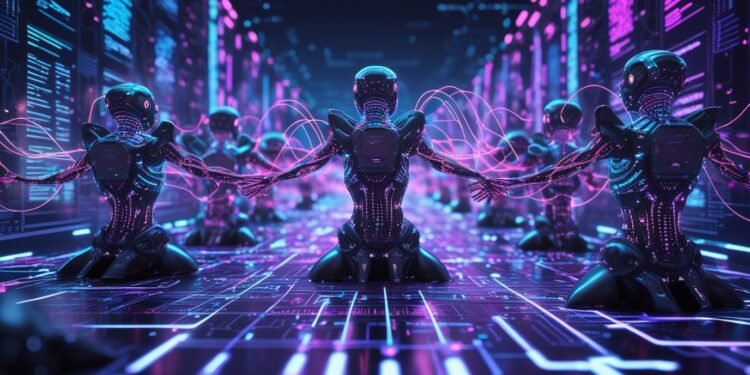Artificial intelligence is no longer confined to isolated systems performing single tasks. In 2025, we’re entering the era of multi-agent AI systems—collaborative environments where multiple intelligent agents interact, share information, and work together to achieve complex objectives. These systems are shaping the future of automation, decision-making, and intelligent coordination across industries ranging from robotics to finance to smart infrastructure.
What Are AI Multi-Agent Systems?
A multi-agent system (MAS) is a network of autonomous entities—called agents—that can perceive their environment, process information, and perform actions to reach individual or shared goals. These agents can be software programs, physical robots, or a mix of both, depending on the context.
Each agent in a MAS is designed to operate independently but also to collaborate or compete with other agents. This collaborative structure allows for:
- Distributed problem-solving
- Emergent behavior
- Parallel task execution
- Scalability across large environments
Unlike single-agent systems, which may struggle with complex, multi-dimensional environments, MAS architectures excel at adaptability, resilience, and scalability.
Key Components of Multi-Agent Collaboration
Collaboration between agents hinges on several core elements:
1. Communication
Agents must communicate effectively—sharing observations, goals, and strategies. This is often accomplished via message-passing protocols or shared knowledge bases. Techniques include:
- Direct peer-to-peer messaging
- Broadcast communication
- Publish/subscribe models
2. Coordination
Agents coordinate their actions to avoid redundancy or conflict. Coordination techniques include:
- Task allocation and division of labor
- Resource management
- Synchronization of activities
3. Negotiation and Decision Making
When agents have conflicting goals or resource needs, negotiation protocols help reach consensus. Techniques include:
- Contract nets
- Voting systems
- Auction-based mechanisms
4. Cooperation and Shared Goals
Some MAS are built around shared objectives. In such systems, agents may:
- Share intermediate results
- Adjust behaviors to support others
- Form coalitions or hierarchies
Real-World Applications of Multi-Agent AI
1. Autonomous Vehicles
Fleet coordination of autonomous cars, delivery drones, and robotic systems relies heavily on MAS. Agents communicate in real time to optimize routes, avoid collisions, and adapt to changing traffic conditions.
2. Smart Grids and Infrastructure
Energy management systems use agents to monitor consumption, control distribution, and respond to demand fluctuations. These agents collaborate to stabilize the grid and reduce energy waste.
3. Supply Chain Optimization
In logistics, each agent can represent a warehouse, vehicle, or distributor. They coordinate to optimize inventory management, delivery routes, and order fulfillment in real-time.
4. Robotics and Swarm Intelligence
MAS enables groups of robots—like warehouse bots or drone swarms—to work together on tasks such as exploration, mapping, and construction. The result is high efficiency, adaptability, and resilience.
5. Finance and Market Simulation
In algorithmic trading and market simulations, agents represent traders with individual goals. Their interactions help model market dynamics, test policies, or even stabilize financial systems through collaborative regulation.
Challenges in Building Collaborative Multi-Agent Systems
Despite the benefits, MAS development introduces several unique challenges:
- Scalability: As the number of agents increases, communication overhead and coordination complexity rise.
- Trust and Reliability: Agents must rely on shared information, which introduces risks if some agents fail or behave maliciously.
- Conflict Resolution: Balancing competition and cooperation can be difficult, especially in systems where agents are owned by different stakeholders.
- Learning and Adaptation: Multi-agent reinforcement learning (MARL) adds layers of complexity, as agents must learn not just from the environment but from each other.
Advances in Multi-Agent Reinforcement Learning (MARL)
MARL is a subfield of AI where agents learn to optimize behavior in shared environments using reinforcement learning principles. Key innovations include:
- Centralized training with decentralized execution (CTDE)
- Curriculum learning for complex collaboration tasks
- Emergent communication through neural networks
These techniques allow MAS to evolve dynamically and develop strategies that outperform rigid, rule-based systems.
The Future of Multi-Agent Systems
Looking ahead, MAS will be foundational to AI-driven ecosystems, especially in autonomous decision-making and distributed intelligence. As computing resources become more decentralized (e.g., edge and fog computing), MAS will thrive by mirroring the architecture of the real world: decentralized, dynamic, and full of interacting components.
We’re witnessing a shift toward collective intelligence—where the collaboration of simple agents results in sophisticated problem-solving capabilities. Whether managing smart cities, controlling robotic fleets, or simulating economies, AI multi-agent systems are redefining what’s possible when intelligence works together.
Conclusion
Multi-agent systems represent a powerful paradigm in artificial intelligence: cooperation among autonomous entities to achieve outcomes far beyond the reach of individual agents. By enabling distributed intelligence, seamless communication, and goal alignment, MAS are laying the foundation for a new era of collaborative, adaptive AI. As these systems evolve, they will become central to the automation and optimization of real-world environments, helping solve problems too complex for any single system to tackle alone.


















